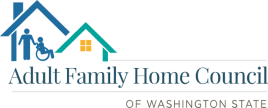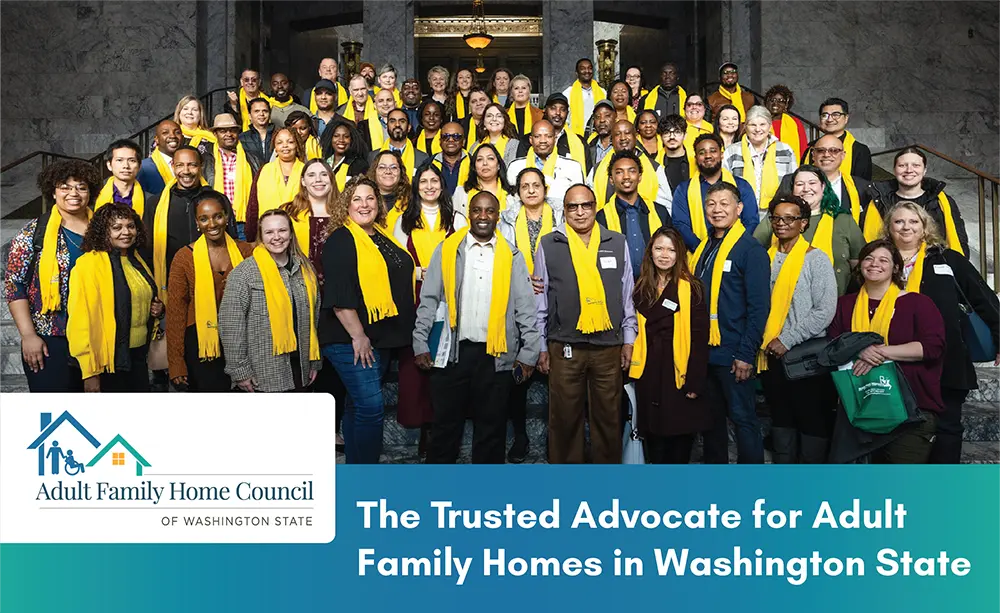
There's a WAC for That!
Orientation & Safety Training Updates
Ensuring your staff is well-prepared to deliver safe, compassionate care starts with strong orientation and safety training. This newsletter provides essential updates and guidance on meeting training requirements—and how you can take the lead in delivering your own approved training program.
Orientation Training: What You Need to Know
WAC 388-76-10340
There are two types of orientation training:
- Facility Orientation Training
- Required for volunteers and staff exempt from certification (RCW 18.88B.041).
- Must be completed before routine interaction with residents.
- Covers basic information about your facility and the population served.
- No DSHS approval or testing required.
- Long-Term Care Worker Orientation Training
- Required for staff who must complete the 70-hour Home Care Aide Basic Training.
- A 2-hour course covering the worker’s role and employment terms (WAC 388-112A-0210).
- Must be completed before providing care.
- Must be taught by DSHS-approved instructors using approved curriculum.
- No test is required.
Safety Training: Protecting Residents and Staff
WAC 388-112A-0220
- A 3-hour training required for all long-term care workers not exempt from certification.
- Must be completed before providing care.
- Covers basic safety precautions, emergency procedures, and infection control (WAC 388-112A-0230).
- Must be taught by qualified instructors using DSHS-approved curriculum.
- No test is required.
Want to Provide Your Own Training? Here’s How!
AFH Providers can conduct their own orientation and safety training by submitting a Facility Training Program Application to the Department of Social and Health Services (DSHS). This allows you to:
- Use DSHS-developed curriculum or
- Create and submit your own custom curriculum for approval.
Once approved, you can issue Continuing Education (CE) certificates and ensure your training aligns with state standards.
Apply Here: Facility Training Program Application and Updates (DSHS Form 15-555)
Benefits of In-House Training
- Flexibility in scheduling and content delivery
- Tailored training to your facility’s unique needs
- Cost-effective and efficient onboarding
- Empowerment to maintain high standards of care
Resources
Related WAC
WAC 388-112A-0200
What is orientation training, who should complete it, and when should it be completed?
There are two types of orientation training: Facility orientation training and long-term care worker orientation training.
(1) Facility orientation. Individuals who are exempt from certification as described in RCW 18.88B.041 and volunteers are required to complete facility orientation training before having routine interaction with residents. This training provides basic introductory information appropriate to the residential care setting and population served. The department does not approve this specific orientation program, materials, or trainers. No test is required for this orientation.
(2) Long-term care worker orientation. Individuals required to complete the 70-hour home care aide basic training must complete long-term care worker orientation, which is two hours of training regarding the long-term care worker’s role and applicable terms of employment as described in WAC 388-112A-0210.
(a) All long-term care workers who are not exempt from home care aide certification as described in RCW 18.88B.041 hired on or after January 7, 2012, must complete two hours of long-term care worker orientation training before providing care to residents.
(b) Long-term care worker orientation training, unless taken through a department approved online training program, must be provided by qualified instructors that meet the requirements in WAC 388-112A-1260.
(c) The department must approve long-term care worker orientation curricula and instructors.
(d) There is no competency test for long-term care worker orientation.
WAC 388-112A-0210
What content must be included in facility and long-term care worker orientation?
(1) For those individuals identified in WAC 388-112A-0200(1) who must complete facility orientation training:
(a) Orientation training may include the use of videos, audio recordings, and other media if the person overseeing the orientation is available to answer questions or concerns for the person(s) receiving the orientation. Facility orientation must include introductory information in the following areas:
(i) The care setting;
(ii) The characteristics and special needs of the population served;
(iii) Fire and life safety, including:
(A) Emergency communication (including phone system if one exists);
(B) Evacuation planning (including fire alarms and fire extinguishers where they exist);
(C) Ways to handle resident injuries and falls or other accidents;
(D) Potential risks to residents or staff (for instance, challenging resident behaviors and how to handle them); and
(E) The location of home policies and procedures;
(iv) Communication skills and information, including:
(A) Methods for supporting effective communication among the resident/guardian, staff, and family members;
(B) Use of verbal and nonverbal communication;
(C) Review of written communications and documentation required for the job, including the resident’s service plan;
(D) Expectations about communication with other home staff; and
(E) Who to contact about problems and concerns;
(v) Standard precautions and infection control, including:
(A) Proper hand washing techniques;
(B) Protection from exposure to blood and other body fluids;
(C) Appropriate disposal of contaminated/hazardous articles;
(D) Reporting exposure to contaminated articles, blood, or other body fluids; and
(E) What staff should do if they are ill;
(vi) Resident rights, including:
(A) The resident’s right to confidentiality of information about the resident;
(B) The resident’s right to participate in making decisions about the resident’s care and to refuse care;
(C) Staff’s duty to protect and promote the rights of each resident and assist the resident to exercise these rights;
(D) How staff should report concerns they may have about a resident’s decision pertaining to their care and who they should report these concerns to;
(E) Staff’s duty to report any suspected abuse, abandonment, neglect, or exploitation of a resident;
(F) Advocates that are available to help residents (such as long-term care ombudsmen and organizations); and
(G) Complaint lines, hot lines, and resident grievance procedures such as, but not limited to:
(I) The DSHS complaint hotline at 1- 800-562-6078;
(II) The Washington state long-term care ombudsman program;
(III) The Washington state department of health and local public health departments;
(IV) The local police;
(V) Facility grievance procedure; and
(b) In adult family homes, safe food handling information must be provided to all staff, prior to handling food for residents.
(2) For long-term care worker orientation required of those individuals identified in WAC 388-112A-0200(2), long-term care worker orientation is a two hour training that must include introductory information in the following areas:
(a) The care setting and the characteristics and special needs of the population served;
(b) Basic job responsibilities and performance expectations;
(c) The care plan or negotiated service agreement, including what it is and how to use it;
(d) The care team;
(e) Process, policies, and procedures for observation, documentation, and reporting;
(f) Resident rights protected by law, including the right to confidentiality and the right to participate in care decisions or to refuse care and how the long-term care worker will protect and promote these rights;
(g) Mandatory reporter law and worker responsibilities as required under chapter 74.34 RCW; and
(h) Communication methods and techniques that may be used while working with a resident or guardian and other care team members.
(3) One hour of completed classroom instruction or other form of training (such as a video or online course) in long-term care orientation training equals one hour of training. The training entity must establish a way for the long-term care worker to receive feedback from an approved instructor or a proctor trained by an approved instructor.
WAC 388-112A-0220
What is safety training, who must complete it, and when should it be completed?
(1) Safety training is part of the long-term care worker requirements. It is a three hour training that must meet the requirements as described in WAC 388-112A-0230, and include basic safety precautions, emergency procedures, and infection control. Safety training must be completed prior to providing care to a resident.
(2) All long-term care workers who are not exempt from home care aide certification as described in RCW 18.88B.041 hired after January 7, 2012, must complete three hours of safety training. This safety training must be provided by qualified instructors who meet the requirements in WAC 388-112A-1260.
(3) The department must approve safety training curricula and instructors.
(4) There is no competency test for safety training.
Not a Member Yet?
Membership fees enable the Council to cover legal expenses and fund staff to advocate with the state and regulatory agencies. The participation of every adult family home is vital to ensuring fair regulations and rates that accurately reflect the costs of caring for our vulnerable adults. Consider becoming a member of the Council to help us continue improving conditions for all adult family homes in Washington State.

